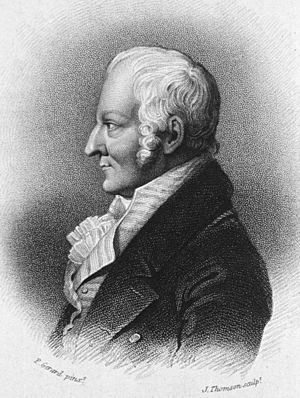Thomas Cogan facts for kids
Thomas Cogan (born February 8, 1736, died February 2, 1818) was an English doctor. He was also a writer who thought deeply about life and ideas. He helped start the Royal Humane Society, which saves lives. Cogan was a Nonconformist, meaning he didn't follow the main Church of England.
Contents
Cogan's Life Story
Thomas Cogan was born in Rothwell, Northamptonshire on February 8, 1736. He had a half-brother named Eliezer Cogan. When he was young, Thomas went to a special school called a dissenting academy in Kibworth Beauchamp. He left at age fourteen and spent two years with his father.
Later, he went to other academies, but he started to have doubts about some religious teachings. Because of these doubts, he decided not to become a minister.
Life in the Netherlands
In 1759, Cogan moved to the Netherlands. He found a job helping the English minister at a church in Rotterdam. He still wanted to be a minister in England. Around 1762, he became a minister in Southampton. However, he soon changed his religious views and became a Unitarian. This caused problems with his church, so he moved back to the Netherlands.
He became a junior minister at an English church in the Hague. There, he met a wealthy banker's daughter and they fell in love. A condition for their marriage was that Cogan become a doctor. So, he went to Leyden University in 1765 and became a doctor in 1767. He worked as a doctor for a few years in Dutch cities like Amsterdam and Rotterdam.
Returning to England
Cogan later moved back to London, England. He became a successful doctor, especially helping mothers with childbirth. By 1780, he returned to the Netherlands with his wife. They lived in a large house called Zuylestein until 1795, when French soldiers invaded.
After that, they moved to Colchester and then settled in Bath, Somerset. Cogan became interested in farming and rented farms in different places. His wife passed away in Bath in 1810. Cogan then moved back to London. He spent his last years there and at his brother's house. He died on February 2, 1818, and was buried in Hackney.
Starting the Royal Humane Society
In 1767, a group in Amsterdam started a society to save people from drowning. Cogan learned about this idea. When he returned to England, he found that another doctor, Dr. William Hawes, had a similar plan.
In the summer of 1774, Cogan and Hawes worked together. They each brought fifteen friends to a meeting, and that's how the Royal Humane Society was created! This society helps save people who have had accidents in water.
Cogan translated a book about the Dutch society to help the English one. He also wrote the first six yearly reports for the new English society. He cared about this work his whole life. He even started a branch of the society in Bath in 1805. In his will, he left money to the society. One of the society's gold medals is made in his memory, and a picture of him is in their 1814 report.
Cogan's Writings
Thomas Cogan wrote many books and papers. His first medical paper was about how feelings affect our health.
He also wrote a travel book called The Rhine, which described a journey he took in 1791 and 1792. He also translated a book from Dutch about how anatomy (the study of the body) connects to art.
Cogan wrote many books about feelings and human behavior. Some of his most famous works include:
- A Philosophical Treatise on the Passions (1800)
- Ethical Treatise on the Passions (1807 and 1810)
- Theological Disquisitions on Religion as affecting the Passions and on the Characteristic Excellencies of Christianity (1812 and 1813)
All five of these books were published together in 1813. His goal was to understand "the moral history of man in his pursuits, power, and motives of action." He also wrote about religious ideas, arguing against some common beliefs of his time.


